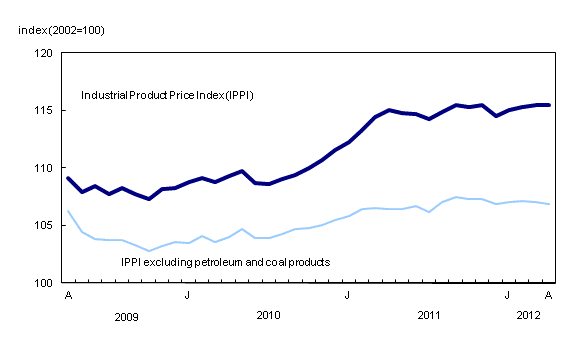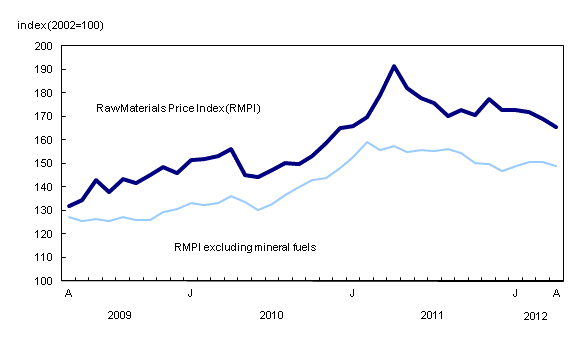Industrial product and raw materials price indexes, April 2012
Archived Content
Information identified as archived is provided for reference, research or recordkeeping purposes. It is not subject to the Government of Canada Web Standards and has not been altered or updated since it was archived. Please "contact us" to request a format other than those available.
Related subjects
-
[an error occurred while processing this directive]
Relative to March, the Industrial Product Price Index (IPPI) was unchanged in April. Increases in chemical products (+1.7%) and petroleum and coal products (+0.4%) were offset by a decline in primary metal products (-2.1%). The Raw Materials Price Index (RMPI) fell 2.0%, largely because of mineral fuels.
Prices for industrial goods unchanged

Chart description: Prices for industrial goods unchanged
Industrial Product Price Index, monthly change
After three consecutive advances, the IPPI was steady in April. Of the major commodity groups, eight were up, nine were down and four were unchanged.
Among the commodities that rose, chemical products (+1.7%) and petroleum and coal products (+0.4%) were the most influential.
The increase in chemical products was mainly attributable to fertilizers (+12.2%), specifically urea (+30.5%). Higher urea prices were partly a result of strong demand in the United States.
Petroleum and coal products were pushed upward mainly by gasoline prices (+2.7%), which posted their fourth consecutive gain.
In contrast, declines in prices of primary metal products (-2.1%), especially aluminum products (-3.7%), copper and copper alloy products (-4.5%), nickel products (-4.4%) and other non-ferrous metal products (-1.9%), partly offset the increases in chemicals and in petroleum and coal products.
Decreases were also observed in meat, fish and dairy products (-0.5%) and motor vehicles and other transportation equipment (-0.1%).
Some Canadian producers who export their products are generally paid on the basis of prices set in US dollars. Consequently, the 0.1% increase in the value the Canadian dollar relative to the US dollar in April had the effect of slightly reducing the corresponding prices in Canadian dollars. However, the exchange rate had a negligible impact on the index as a whole.
In April, the IPPI excluding petroleum and coal products edged down 0.1% for the second consecutive month.
12-month change in the Industrial Product Price Index
Compared with the same month a year earlier, the IPPI rose 0.4% in April. The slowdown of the growth of the index has continued since September 2011.
The increase in the IPPI was led by higher prices for motor vehicles and other transportation equipment (+2.7%).
More modest advances were observed in chemical products (+2.5%) and in fruit, vegetables, feeds and other food products (+2.2%).
The growth of the IPPI was moderated largely by a decrease in primary metal products (-9.4%), which posted a sixth consecutive decline. The largest contributors to the decrease were other non-ferrous metal products (-13.0%), nickel products (-29.3%), aluminum products (-11.1%) and copper and copper alloy products (-10.1%).
The 3.5% decline in the value of the Canadian dollar against the US dollar contributed to the growth of the index in April. Without the impact of the exchange rate, the IPPI would have fallen 0.4% instead of increasing 0.4%.
The IPPI excluding petroleum and coal products was up 0.5% relative to April 2011.
Raw Materials Price Index, monthly change
The RMPI declined 2.0% in April, the third consecutive monthly decrease. The downward trend of the index was slightly more pronounced in April, following declines of 0.6% in February and 1.7% in March.
Prices for raw materials decrease

Chart description: Prices for raw materials decrease
In April, the decrease of the index was mostly the result of mineral fuels (-2.8%), particularly crude petroleum (-2.6%).
The decline of the RMPI was moderated primarily by vegetable products (+1.4%), especially oilseeds (+6.5%) and grains (+1.3%).
In the oilseeds group, higher prices were observed for canola (+6.2%) and soybeans (+6.3%). The increase in soybean and canola prices was partly attributable to a decline in global supply, especially in South America, where drought disrupted normal production.
The main contributors to the rise in grain prices were oats (+4.0%), wheat (+2.7%) and barley (+2.0%).
The RMPI excluding mineral fuels posted a 1.3% decrease in April, ending a string of three consecutive monthly advances.
12-month change in the Raw Materials Price Index
Compared with the same month a year earlier, the RMPI was down 13.6%, its second consecutive decrease. The decline of the index was more pronounced in April, partly because it had reached an exceptionally high level a year earlier.
The index was pushed downward mainly by mineral fuels prices (-21.3%) and, to a lesser extent, non-ferrous metals (-12.2%).
Crude petroleum (-21.8%) was primarily responsible for the decline in mineral fuels, posting its second consecutive decrease.
All major non-ferrous metal product groups except precious metals were down. Among the main contributors to the decline were copper concentrates (-12.8%), other non-ferrous base metals (-21.1%), non-ferrous metal scrap (-10.6%) and zinc concentrates (-15.3%).
Year over year, the RMPI excluding mineral fuels declined 5.6% in April.
Note to readers
All data in this release are seasonally unadjusted and usually subject to revision for a period of six months (for example, when the July index is released, the index for the previous January becomes final).
The Industrial Product Price Index (IPPI) reflects the prices that producers in Canada receive as the goods leave the plant gate. It does not reflect what the consumer pays. Unlike the Consumer Price Index, the IPPI excludes indirect taxes and all the costs that occur between the time a good leaves the plant and the time the final user takes possession of it, including transportation, wholesale and retail costs.
Canadian producers export many goods. They often indicate their prices in foreign currencies, especially in US dollars, which are then converted into Canadian dollars. In particular, this is the case for motor vehicles, pulp, paper and wood products. Therefore, a rise or fall in the value of the Canadian dollar against its US counterpart affects the IPPI. But the conversion into Canadian dollars only reflects how respondents provide their prices. Moreover, this is not a measure that takes into account the full effect of exchange rates, since that is a more difficult analytical task.
The conversion of prices received in US dollars is based on the average monthly exchange rate (noon spot rate) established by the Bank of Canada and is available on CANSIM in table 176-0064 (series v37426). Monthly and annual variations in the exchange rate, as described in the text, are calculated according to the indirect quotation of the exchange rate (for example, CAN$1 = US$X).
The Raw Materials Price Index (RMPI) reflects the prices paid by Canadian manufacturers for key raw materials. Many of those prices are set on the world market. However, as few prices are denominated in foreign currencies, their conversion into Canadian dollars has only a minor effect on the calculation of the RMPI.
Available without charge in CANSIM: tables CANSIM table329-0056 to 329-0068 and CANSIM table330-0007.
Table 329-0056: Industrial Product Price Index by major commodity aggregations.
Table 329-0057: Industrial Product Price Index by industry.
Table 329-0058: Industrial Product Price Index by stage of processing.
Tables 329-0059 to 329-0068: Industrial Product Price Index by commodity.
Table 330-0007: Raw Materials Price Index by commodity.
Definitions, data sources and methods: survey numbers survey number2306 and survey number2318.
The April 2012 issue of Industry Price Indexes (Catalogue number62-011-X, free) will soon be available.
The industrial product and raw materials price indexes for May will be released on June 29.
For more information, or to enquire about the concepts, methods or data quality of this release, contact Statistics Canada's National Contact Centre (toll-free 1-800-263-1136; 613-951-8116; infostats@statcan.gc.ca) or the Media Hotline (613-951-4636; statcan.mediahotline-ligneinfomedias.statcan@canada.ca).
- Date modified:
